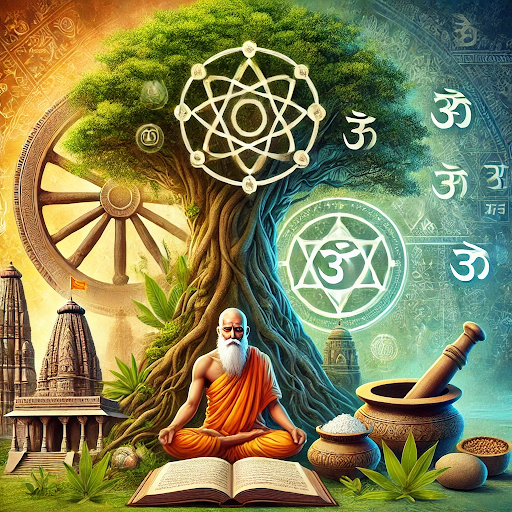Ancient Indian philosophies and practices present a rich repository of concepts addressing mental wellness. Rooted in holistic and integrative approaches, they emphasize harmony between the mind, body, and spirit, offering valuable lessons for contemporary mental health challenges.
1. Concept
of the Mind in Ancient India
- Manas (Mind):
- Regarded as the interface between the body and the soul (Atman),
the mind governs perception, thought, and action.
- The mind’s balance (Sattva), restlessness (Rajas),
and inertia (Tamas) influence mental health, as described in the Triguna
theory of Samkhya philosophy.
- Chitta (Consciousness):
- Encompasses memory, awareness, and the subtle aspects of the mind.
Disturbances in Chitta lead to mental unrest and imbalance.
2. Dhyana
(Meditation) and Mental Wellness
- Definition and Practice:
- Dhyana, or meditation, is a
state of focused awareness that calms the mind and promotes clarity.
- Practices like mindfulness (Vipassana) and transcendental
meditation enhance emotional regulation and mental resilience.
- Benefits:
- Reduces anxiety, stress, and depressive symptoms.
- Enhances concentration, self-awareness, and inner peace.
3.
Mind-Body Relationship
- Ancient Indian systems recognized the inseparability of the mind
and body.
- The Ayurvedic view emphasizes the balance of doshas
(Vata, Pitta, Kapha) for holistic health. Mental imbalances often manifest
as physical ailments, underscoring the need for integrative care.
- Yoga postures (asanas) and breathing exercises (pranayama)
are designed to harmonize the mind-body connection, fostering relaxation
and stability.
4.
Ayurveda’s Perspective on Mental Health
- Sattvavajaya Chikitsa (Psychological Therapy):
- Focuses on restoring Sattva (mental clarity and strength)
through mindfulness, positive thinking, and emotional regulation.
- Herbal Remedies:
- Herbs like Brahmi, Ashwagandha, and Jatamansi
are used for their calming and rejuvenating properties.
- Lifestyle Practices:
- Daily routines (Dinacharya), balanced diets, and ethical
living (Dharma) support mental well-being.
5. Yoga
Darshan
- The Yoga Sutras of Patanjali provide a step-by-step
framework for mental and spiritual well-being through:
- Yamas (ethical disciplines) and
Niyamas (self-purification practices).
- Asanas (postures) and Pranayama
(breath control) for physical and mental equilibrium.
- Samadhi (ultimate state of
meditation) for transcendence and self-realization.
6. Atman
(Soul) and Self-Awareness
- The concept of Atman emphasizes the eternal, unchanging
essence within each individual.
- Understanding one’s Atman through self-inquiry and
meditation fosters resilience and detachment from transient mental
afflictions.
7.
Relevance of Ancient Indian Mental Health Practices Today
- Stress Management:
Techniques like yoga, meditation, and Ayurvedic therapies address modern
stressors effectively.
- Holistic Healing:
Integrates mental, physical, and spiritual well-being.
- Preventive Care:
Encourages proactive self-care through balanced living and mindfulness.
- Global Recognition:
Practices like yoga and meditation are now widely adopted worldwide for
their scientifically proven mental health benefits.
By integrating these time-tested principles,
ancient Indian mental health practices continue to inspire sustainable and
comprehensive approaches to mental wellness in modern life.



